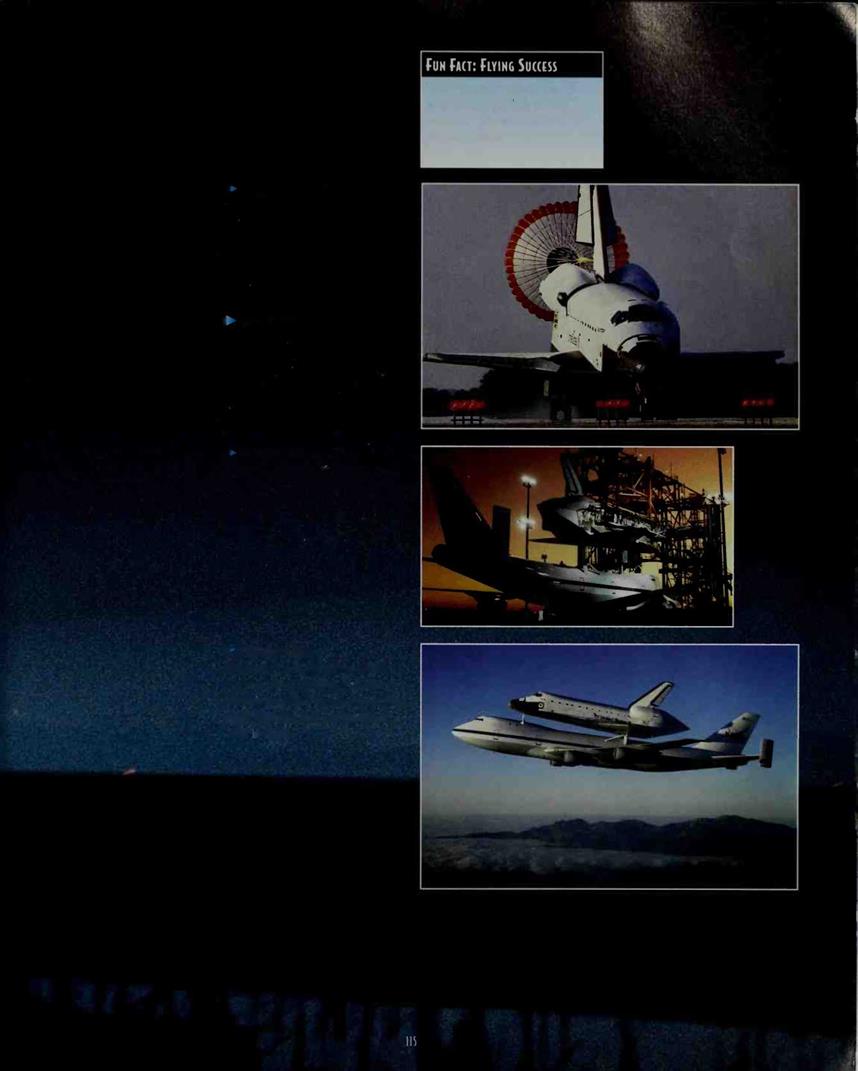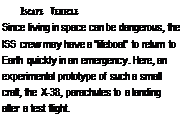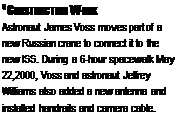Gliding Home
ETURNING to Earth, the shuttle orbiter is transformed from a spacecraft into a giant glider.
First, its maneuvering engine rockets fire a last time to slow it down to drop from orbit.
Reentering Earth’s atmosphere, it passes through scorch mg heat and tremendous friction. The thermal heat shield does its job well and protects the ship during the fiery journey. Next, computers guide the orbiter through a series of S turns to slow it down more. I he orbiter’s speed drops f rom over 17,000 miles an hour to about 350 miles an hour.

The craft glides in silently. At about 20 miles from the runway, the mission commander takes control and brings it in lor a landing. The shuttle can also land automatically, if necessary. As the wheels touch down, the craft lands at between 200 and 226 miles an hour and slows to a stop. Then the astronauts exit the orbiter on ordinaiy
 I Coming in to Land
I Coming in to Land
Like a giant bird, the shuttle Columbia ghees unpowered to land at Kennedy Space Center. The commander aims carefully landing the craft. If it misses the runway, he cannot turn around to core Pack and try again.
і What a Drag
Once the shuttle’s wheels hit the runway, a parachute opens to slow the orbiter.
As the craft lands at over 200 miles an hour, the drag chute helps it gradually b^ake to a stop.
► Getting д Lift
The shuttle Atlantis is lifted in a machine to mount it on the back of з Boeing 747. With no power to fly through the atmosphere after it lands, the shuttle orbiter must be ferried by a 7<r back to its launch site.
► Piggyback Ride
Aboard a 747 ferry, the shuttle Atlantis returns to Florida after being repaired in California. Shuttles are used over and over, always launching from Kennedy Space Center n Florida.
today’s four space shuttles have all flown many times. Since the first mission in 1981, there have been over 100 shuttle flights.
HE largest object ever built in space, the International Space Station (ISS) Floats in Earth orbit in an artist’s concept. Begun in 1998, it will sprawl twice the size ol a football held when complete. The ISS is being built jointly bv 16 nations, including the United States, Russia, Canada, countries of the European Space Agency, and Japan. It will cost about $60 billion.
 |
Already’ home to an American-Russian crew, the station has a roomy kitchen, bathroom, and sleeping and exercise areas. Omni solar panels convert energy From the Sun lor electric power. The station will provide an international center For many kinds ol scientific research. In its laboratories, scientists will study lile in space and test new medicines and materials lor use on Earth. One day, the ISS may also be the departure terminal For missions to other planets.
^ Outpost in Space
leveling 770 miles high over Fdrth, the International Space Station is shown as it will look when complete, around 2006.
A crew of 7 will live m a space as big as two 747 jet cabins. The size of two football fields, the station will weigh a million pounds.
Fun Fact: Big Job
More than 40 trips by space shuttle and other craft will be required to deliver the parts, supplies, and equipment needed to build the ISS.
|
|
|
![]()
![]()


 SOME 220 miles over Earth, the world’s highest
SOME 220 miles over Earth, the world’s highest
construction site bustles with activity and work is in lull swing. Workers move cranes hoisting huge building blocks. The giant structure going up is the International Space Station. The workers building it are astronauts.
The construction work will continue lor five years. The astronauts will spend many hours of spacewalks assembling the station. They will get help from a large robotic arm made in Camida and possibly a flying robotic “eye” that can circle around to inspect the huge station.
In the finished station, scientists believe the absence of gravity will allow them to do experiments not possible on Earth. They hope to develop new drugs, new ways to treat and prevent diseases, more powerful computer chips, stronger metals, and better weather forecasting systems. Life on the ISS will also provide knowledge for future space travel beyond Earth’s orbit.
Early Space Station
In May 2000, the first parts of the new ISS orbit Earth. The station at this stage has two sections, or modules. The first U. S. module, Unity (top), is joined to the Russian power and propulsion module, Zarya ("Sunrise").

 * All Systems Go
* All Systems Go
In this artist’s concept, a space shuttle has docked at the finished ISS. When complete, the station will be a busy center of scientific research, new discoveries, and exciting plans for future missions to explore space.










